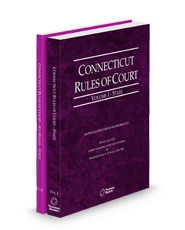Connecticut Rules of Court – State and State KeyRules (Vols. I-IA) provides the rules of court and civil practice guides needed to practice before the state courts of Connecticut.
Connecticut Rules of Court – State (Vol. I) provides state rules of court, including:
- Rules for the Superior Court
- General Provisions
- Procedure in Civil Matters
- Procedure in Family Matters
- Procedure in Juvenile Matters
- Procedure in Criminal Matters
- Rules of Appellate Procedure
- Appendix of Forms
- Code of Evidence with Author Commentary
- Code of Judicial Conduct
- Code of Probate Judicial Conduct
- Rules of Professional Conduct
- Statewide Grievance Committee Rules of Procedure
- Grievance Panel Rules of Procedure
- Probate Court Rules and Procedure
- Superior Court Standing Orders
- Fairfield Judicial District Standing Orders
- Hartford Judicial District Standing Orders
- New Haven Judicial District Standing Orders
- And more
Connecticut Rules of Court – State KeyRules (Vol. IA) identifies, organizes, and provides, in outline format, the court rules, statutes, caselaw, and secondary sources needed to draft, file, and serve common civil court filings in the state courts of Connecticut. Each
KeyRules outline corresponds to a specific pleading, motion, or discovery request, providing the applicable procedural rules and integrating them into sections by rule type (e.g., timing, format, filing and service, etc.). The procedural rule content is further enhanced with on-point caselaw and industry-leading Thomson Reuters secondary sources.
KeyRules provides attorneys, paralegals, and other legal staff with the information needed to draft, file, and serve their court documents quickly and correctly. Key features include:
- Outlines for more than a dozen of the most commonly filed pleadings, motions, and discovery requests
- Clear, intuitive presentation of the applicable procedural rules by document type and rule type to easily locate procedural requirements throughout the drafting and filing process
- Enhancement of rule content with on-point caselaw and industry-leading Thomson Reuters secondary sources for clear understanding of procedural requirements
- Inclusion of corresponding court forms, filing checklists, and sample court documents to promote drafting and filing economies and reduce drafting and filing errors
- Regular updates of KeyRules content to account for changes in law

